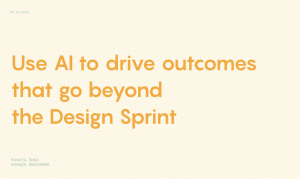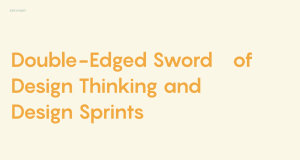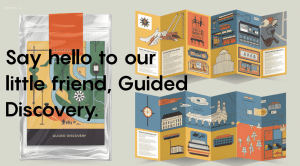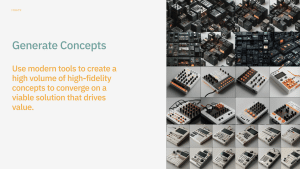Day 3 Session Notes–Use AI to Drive Outcomes that Go Beyond the Design Sprint

— Thank you and get things started by thanking rest of curation team as today has been stellar and really compelling
- Dove-tail on final thoughts and being provided agency to experiment is invitation to innovate
— Focus on innovation in action
- Take through framework that operates likes recipe rather than formal equation

— Did great job introducing us
- Joe started business called Gyroscope and worked for many verticals and brands
- Pooria worked in AI for combined 20 years

— Pooria did Generative AI at Autodesk and showing off AI avatars and working to get hair to that level

— Why are we here? Kick off story-time with an origin story of guided discovery, walk through framework with drivers and outcomes, going through case study and project through completion and clearance to share
- Wrap up with pragmatic tips

— Why are we here? Kick off story-time with an origin story of guided discovery, walk through framework with drivers and outcomes, going through case study and project through completion and clearance to share
- Wrap up with pragmatic tips

— We will start with a bit of negativity and tragic origin story

— Few years ago working for a multinational CPG, and contracted in under external design work, and nothing usual of working on client projects with challenges
— Had perfect storm of bad outcomes
- Narrow scope, strong leader, while also having us look at systemic process issues
- All to be done within a single week
- Throughout this, we were asked to color inside the lines

— Delivered design that was prototype and tested, but…
- Design sprint was wrong tool to use, and client was not aware of other methods working on
- Lot of frustration caused friction, and no one knew what to do next once project solved

— It even might have caused long-term harm
- Design sprints became scapegoat for anything that went wrong
- Old methods design was meant to change were hardened and put back into place

— Design thinking delivers, but is solely outcomes focused and has good elements and bad elements
- But if no value, why doing it?
— Sprint playbook needed improvement

— Wouldn’t be here if design sprints weren’t successful at tacking certain problems
- Things it can’t solve for
— Design sprints focus on high volume thinking, which is not always right solution, and even more so on tight timetable

— If value proposition of design thinking is empathy, we need data to do that
- Led to guided discovery process

— Focus on positive and what guided discovery is
— Recognize that we are taking individuals from multiple disciplines on a journey
- Giving tools and methods for meaningful outcomes on other end and important learnings established along the way

— Framing mechanism around this is AI
- Likely don’t recognize first interaction with AI was Google auto-correct, and it’s targeted ads
— AI now viewed as table stakes for every roadmap, whether as feature enhancement or capability improvement or M&A acquired or acqui-hired by company
- As discipline under the design umbrellas, we need to leverage tools to competitive advantage

— Overview of guided discovery framework and four modules of thinking and doing while a fifth module is dedicated to packaging
— Collection Module
- Shopping for data that’s available, and marketing has data on purchase intent, and buyer data as well
- Customer Experience to give feedback on reliability and utility of items in data
- Development has tons of instrumentation data and higher-level of utility

— Ability to align with partners and make educated hypotheses and 360 degree picture for virtual personas
- First two modules of guided discovery require iteration on virtual persona
— Following module is concept generation and then narrowing in and zooming out
- AI tools to manifest ideas at same level and then diverge or converge
— Accelerated timetable and taking prototype and sharing with virtual persona for directional feedback
- Virtual persona won’t supplant talking to people— but very good for directional feedback
— Refinement and running at very fast rate
— After evaluation high-level roadmapping exercise and scaling and scoping of outcomes and crawl, walk, run of delivery to outline next steps to take
- Dedicated module allowed for playing back understanding
— Take time to align stakeholders and clarify process, prior to packaging

— Creating operating model to understand and grasp subject matter expertise

— How is this unique?
- Virtual persona aggregates data inside org to provider better picture of what persona needs, behaviors, and goals are
- Personas always need enhancement, and driving guidance of discovery
- Data comes from different areas of organization and want to learn more
- Idea generation and using AI tools to diverge wider and level playing field from designers to non-designers
- Teaching partners to use different tolls and methods and documentation of what worked and what didn’t

— Landscape changing all the time, and not one way to deliver this, and encourage you to mix and match

— Reminder of five discrete stages in framework

— Had active project for live music application and niche customers in mind, i.e. sound engineers
- Don’t need to be sound engineers to think like them
— Have AI tools to generate concepts

— And here is overview of how data fed into AI, and data at rest

— Understand context and design sprint, and element that doesn’t get created and take from stakeholder users and buyers and valuable info to items made and feed context
- Share with client and iterating straight from get go

— Concept generation stage, but with Gen AI to dictate type of visual form for product to take and mood-boards from intention
- TLDR of using AI to direct images themselves

— Create a POC, and having AI to interpret sketcher and make it much easier for low fidelity mockups
- AI getting it wrong can lead to new elements for ideation

— Then make sure assumptions get made and correct. Take everything created and interacting with virtual persona
- Evaluation a lot faster and can talk to humans later in process
- Not replacement but augmentation to process

— Creating renders to have curated version of product intention and best elements of this to increase fidelity without effort, and better outcome then print method

— Actually focus on design, and use AI tools throughout design process

— Before final section of pragmatic tips. Can leverage AI tools for creative processes inside Figma and other tools, based on configurations
- More concrete than what client could share

— Here are tips you can use
- Newsletters snd substacks for reference
- Research blogs and non sci-fi sides
— Product releases and research papers and signal to noise in AI space, so take a screen cap

— Can find this without looking hard
- Check out billion dollar teams presentation and same philosophy here

— Always self-paced learning and one way to not let down your instructor and lots of free learning from finest universities in planet

— Most important things for AI tech is to learn to speak AI prompts, and don’t be intimidated by learning curve

— Here are tools we used in process—but this list has a lot of change and changed many times already and first two rows sticking around

— Since technologies always keep evolving, avoid dogma and keep iterating and try out new tools, once you have methodology scale it up

— Thank you for having us, and eager to wrap up

